Aggregate Geometrical Features and Their Influence on the Surface Properties of Asphalt Pavement
Abstract
:1. Introduction
2. Experimental Study
2.1. Raw Materials and Mixture Design
2.1.1. Raw Materials
2.1.2. Mixture Design
2.2. Aggregate Geometrical Features Analysis Method
2.2.1. Image Processing
2.2.2. Aggregate Geometric Features Analysis
2.3. Pavement Surface Property Analysis Method
3. Aggregate Geometrical Features Test Results
3.1. Analysis of Aggregate Form
3.2. Analysis of Aggregate Angularity
3.3. Analysis of Aggregate Surface Texture
3.4. Experimental Verification
3.4.1. Selection of Aggregate Form Characteristic Index
3.4.2. Verification of Aggregate Angularity Characteristic Index
3.4.3. Verification of Aggregate Surface Texture Characteristic Index
4. Statistical Relationships between Pavement Skid Resistance and Aggregate Geometric Features
4.1. Results of Aggregate Geometrical Features in the Mixture
4.2. Statistical Correlations of MTD and MPD with Aggregate Geometrical Features
4.3. Statistical Correlations of WFC with Aggregate Geometric Features
5. Prediction Model of Pavement Surface Properties Based on Aggregate Geometrical Features
6. Conclusions
- (1)
- The Aggregate Geometric Characteristic Evaluation System (i.e., AGCES) developed based on 2-dimensional digital image processing techniques can characterize the form property, angularity characteristics, and surface texture of aggregate particles.
- (2)
- Aggregate with distinct edges and corners and deeper surface texture improves pavement surface roughness, which is manifested as the increase in MTD, MPD and WFC. The form property of aggregate has no significant effect on the surface texture of asphalt pavement.
- (3)
- The prediction models of pavement surface characteristics based on the angularity characteristics and surface texture of aggregate particles are developed according to the study on the influence of aggregate geometrical features on MTD, MPD and WFC. The coefficients of the mentioned models are calculated using Levenberg-Marquart and universal global optimization.
Author Contributions
Funding
Institutional Review Board Statement
Informed Consent Statement
Data Availability Statement
Acknowledgments
Conflicts of Interest
References
- Arasan, S.; Yener, E.; Hattatoglu, F.; Hinislioglua, S.; Akbuluta, S. Correlation between Shape of Aggregate and Mechanical Properties of Asphalt Concrete: Digital Image Processing Approach. Road Mater. Pavement Des. 2011, 12, 239–262. [Google Scholar] [CrossRef]
- Bi, Y.; Guo, F.; Pei, J.; Zhang, J.; Li, R. Correlation between geometric parameters of coarse aggregates and mixing rheological indices of asphalt mixture. Constr. Build. Mater. 2020, 269, 121319. [Google Scholar] [CrossRef]
- Sengoz, B.; Onsori, A.; Topal, A. Effect of aggregate shape on the surface properties of flexible pavement. KSCE J. Civil. Eng. 2014, 18, 1364–1371. [Google Scholar] [CrossRef]
- Zhou, C.; Zhang, M.; Li, Y.; Lu, J.; Chen, J. Influence of particle shape on aggregate mixture’s performance: DEM results. Road Mater. Pavement Des. 2019, 20, 399–413. [Google Scholar] [CrossRef]
- Kusumawardani, D.M.; Wong, Y.D. The influence of aggregate shape properties on aggregate packing in porous asphalt mixture (PAM). Constr. Build. Mater. 2020, 255, 119379. [Google Scholar] [CrossRef]
- Kusumawardani, D.M.; Wong, Y.D. Effect of aggregate shape properties on performance of porous asphalt mixture. J. Mater. Civ. Eng. 2021, 33, 04021208. [Google Scholar] [CrossRef]
- Tutumluer, E.; Huang, H.; Bian, X. Geogrid-aggregate interlock mechanism investigated through aggregate imaging-based discrete element modeling approach. Int. J. Geomech. 2012, 12, 391–398. [Google Scholar] [CrossRef]
- Rao, C.; Tutumluer, E. Determination of volume of aggregates: New image analysis approach. Transp. Res. Rec. 2000, 1721, 73–80. [Google Scholar] [CrossRef]
- Liu, Y.; Sun, W.; Nair, H.; Lane, D.S.; Wang, L. Quantification of aggregate morphologic characteristics as related to mechanical properties of asphalt concrete with improved FTI system. J. Mater. Civ. Eng. 2016, 8, 04016046. [Google Scholar] [CrossRef]
- Fletcher, T.; Chandan, C.; Masad, E.; Sivakumar, K. Aggregate imaging system for characterizing the shape of fine and coarse aggregates. Transp. Res. Rec. 2003, 1832, 67–77. [Google Scholar] [CrossRef] [Green Version]
- Pan, T.; Tutumluer, E. Imaging based evaluation of coarse aggregate size and shape properties affecting pavement performance. In Advances in Pavement Engineering; American Society of Civil Engineers: Reston, VA, USA, 2005; pp. 1–15. [Google Scholar]
- Rao, C.; Tutumluer, E.; Kim, I.T. Quantification of coarse aggregate angularity based on image analysis. Transp. Res. Rec. 2002, 1787, 117–124. [Google Scholar] [CrossRef]
- Topal, A.; Sengoz, B. Determination of fine aggregate angularity in relation with the resistance to rutting of hot-mix asphalt. Constr. Build. Mater. 2005, 19, 155–163. [Google Scholar] [CrossRef]
- Al-Rousan, T.; Masad, E.; Tutumluer, E.; Pan, T. Evaluation of image analysis techniques for quantifying aggregate shape characteristics. Constr. Build. Mater. 2007, 21, 978–990. [Google Scholar] [CrossRef]
- Bessa, I.S.; CasteloBranco, V.T.F.; Soares, J.B.; NogueiraNeto, J.A. Aggregate shape properties and their influence on the behavior of hot-mix asphalt. J. Mater. Civil. Eng. 2015, 27, 04014212.1–04014212.8. [Google Scholar] [CrossRef]
- Pei, J.; Bi, Y.; Zhang, J.; Li, R.; Liu, G. Impacts of aggregate geometrical features on the rheological properties of asphalt mixtures during compaction and service stage. Constr. Build. Mater. 2016, 126, 165–171. [Google Scholar] [CrossRef]
- Hassan, H.M.Z.; Wu, K.; Huang, W.; Chen, S.; Zhang, Q.; Xie, J.; Cai, X. Study on the influence of aggregate strength and shape on the performance of asphalt mixture. Constr. Build. Mater. 2021, 294, 123599. [Google Scholar] [CrossRef]
- Usman, T.; Fu, L.; Miranda-Moreno, L.F. Quantifying safety benefit of winter road maintenance: Accident frequency modeling. Accid. Anal. Prev. 2010, 42, 1878–1887. [Google Scholar] [CrossRef]
- Mataei, B.; Zakeri, H.; Zahedi, M.; Nejad, F.M. Pavement friction and skid resistance measurement methods: A literature review. Open J. Civil. Eng. 2016, 6, 537–565. [Google Scholar] [CrossRef] [Green Version]
- Huang, X.; Zheng, B. Research status and progress for skid resistance performance of asphalt pavements. China J. Highw. Transp. 2019, 32, 32–49. [Google Scholar]
- Shah, S.M.R.; Abdullah, M.E. Effect of aggregate shape on skid resistance of compacted hot mix asphalt (HMA). In Proceedings of the International conference on computer and network technology, Bangkok, Thailand, 23–25 April 2010; pp. 421–425. [Google Scholar] [CrossRef]
- Crouch, L.; Gothard, J.; Head, G.; Goodwin, W. Evaluation of textural retention of pavement surface aggregates. Transp. Res. Rec. 1995, 1486, 124–129. [Google Scholar]
- Abdul-Malak, M.; Fowler, D.W.; Constantino, A. Aggregate characteristics governing performance of seal coat highway overlays. Transp. Res. Rec. 1996, 1547, 15–22. [Google Scholar] [CrossRef]
- Unal, H.; Mimaroglu, A. Evaluation of morphologic characteristics and mechanical performance of rockforce mineral fiber- and glass fiber-reinforced polyamide-6 composites. Sci. Eng. Compos. Mater. 2013, 21, 323–328. [Google Scholar] [CrossRef]
- Chen, D.; Sefidmazgi, N.R.; Bahia, H. Exploring the feasibility of evaluating asphalt pavement surface macro-texture using image-based texture analysis method. Road Mater. Pavement Des. 2015, 16, 405–420. [Google Scholar] [CrossRef]
- Han, S.; Sun, P.; Fwa, T.F. Relationships between internal structure and surface texture of asphalt mixtures. Road Mater. Pavement Des. 2021, 22, 894–909. [Google Scholar] [CrossRef]
- Han, S.; Liu, M.; Fwa, T.F. Testing for low-speed skid resistance of road pavements. Road Mater. Pavement Des. 2020, 21, 1312–1325. [Google Scholar] [CrossRef]
- ASTM International. ASTM D3398 Standard Test Method for Index of Aggregate Particle Shape and Texture; ASTM International: West Conshohocken, PA, USA, 2000. [Google Scholar]

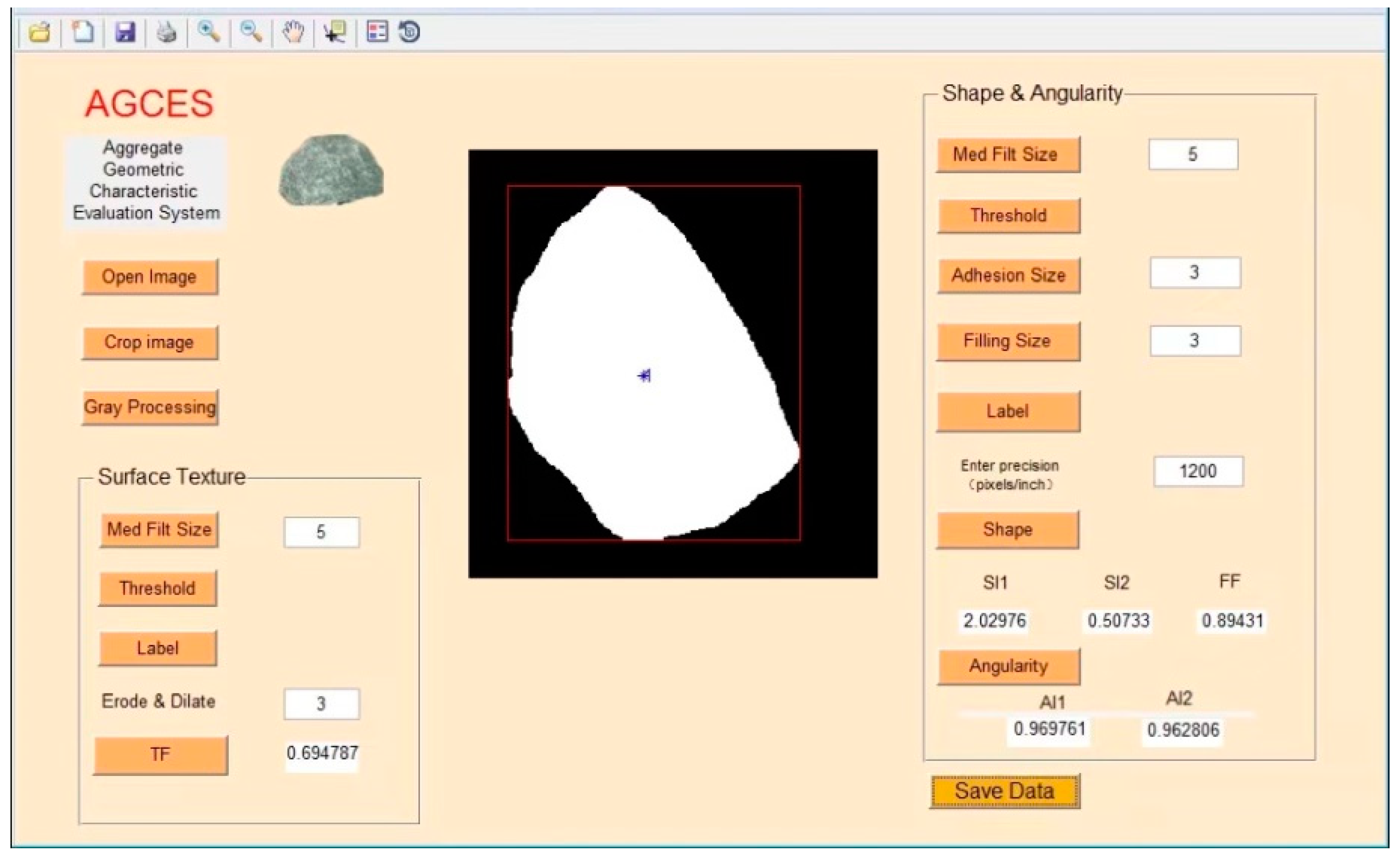
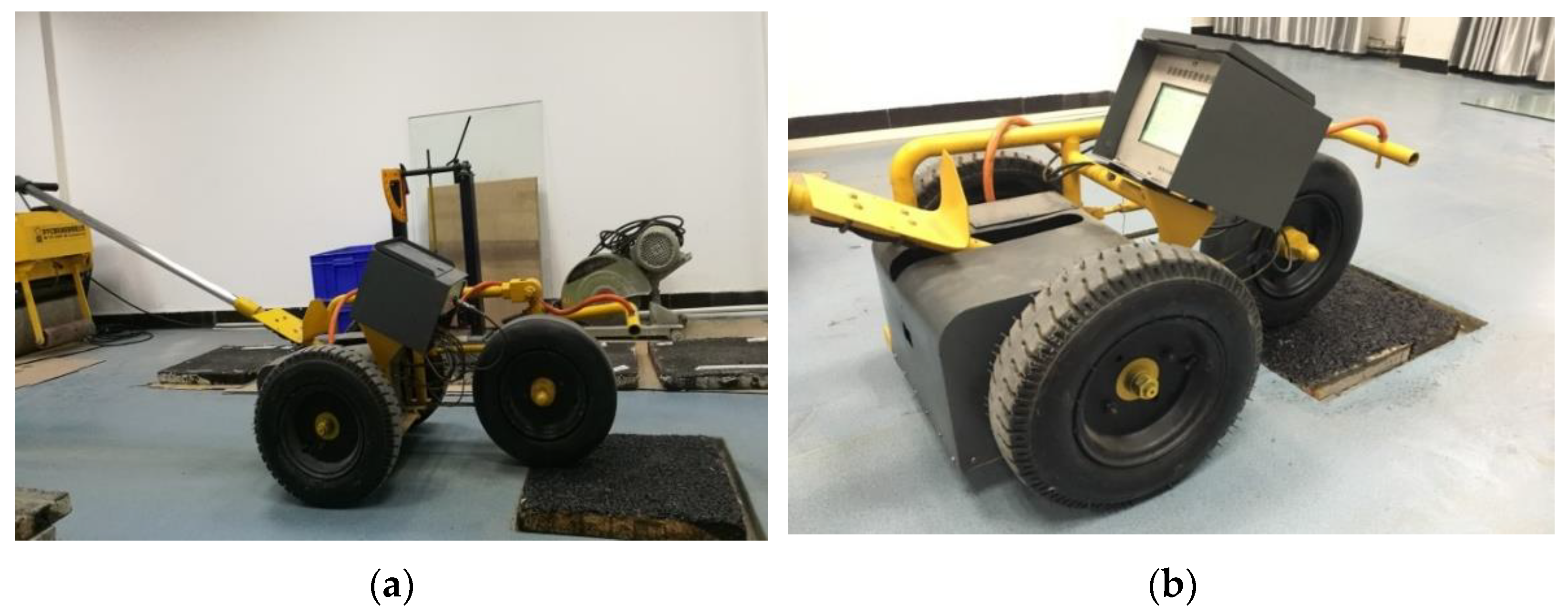
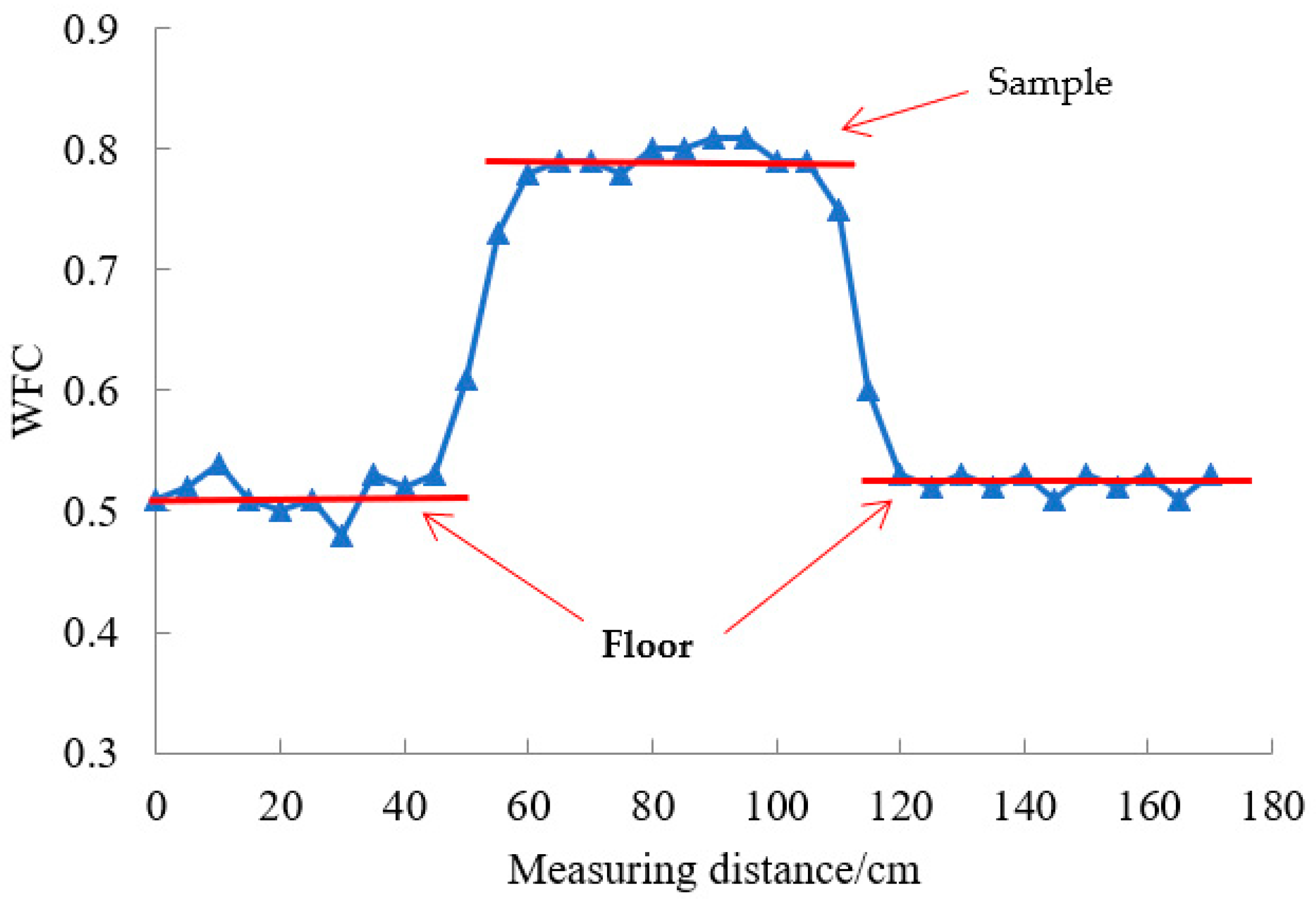

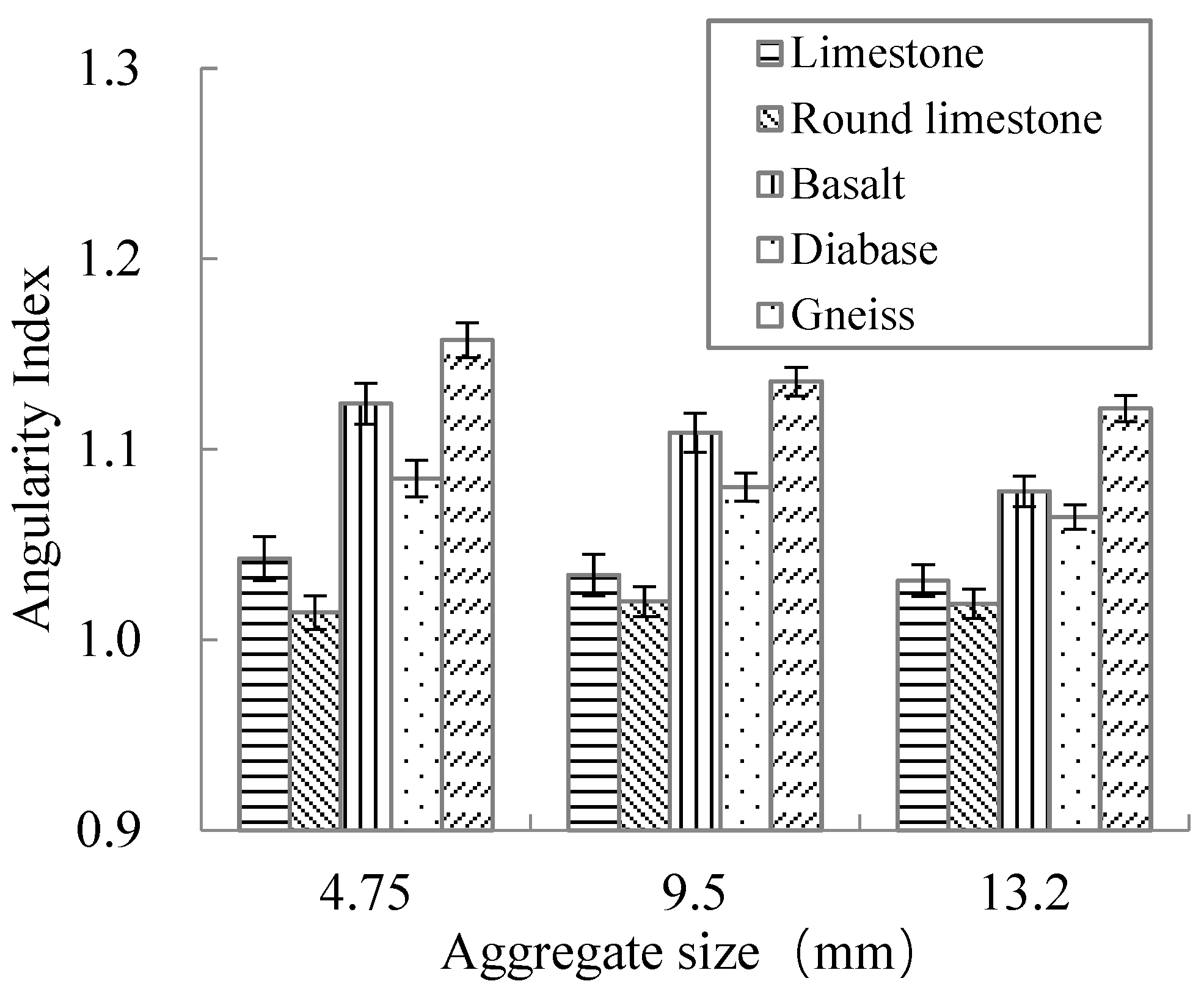
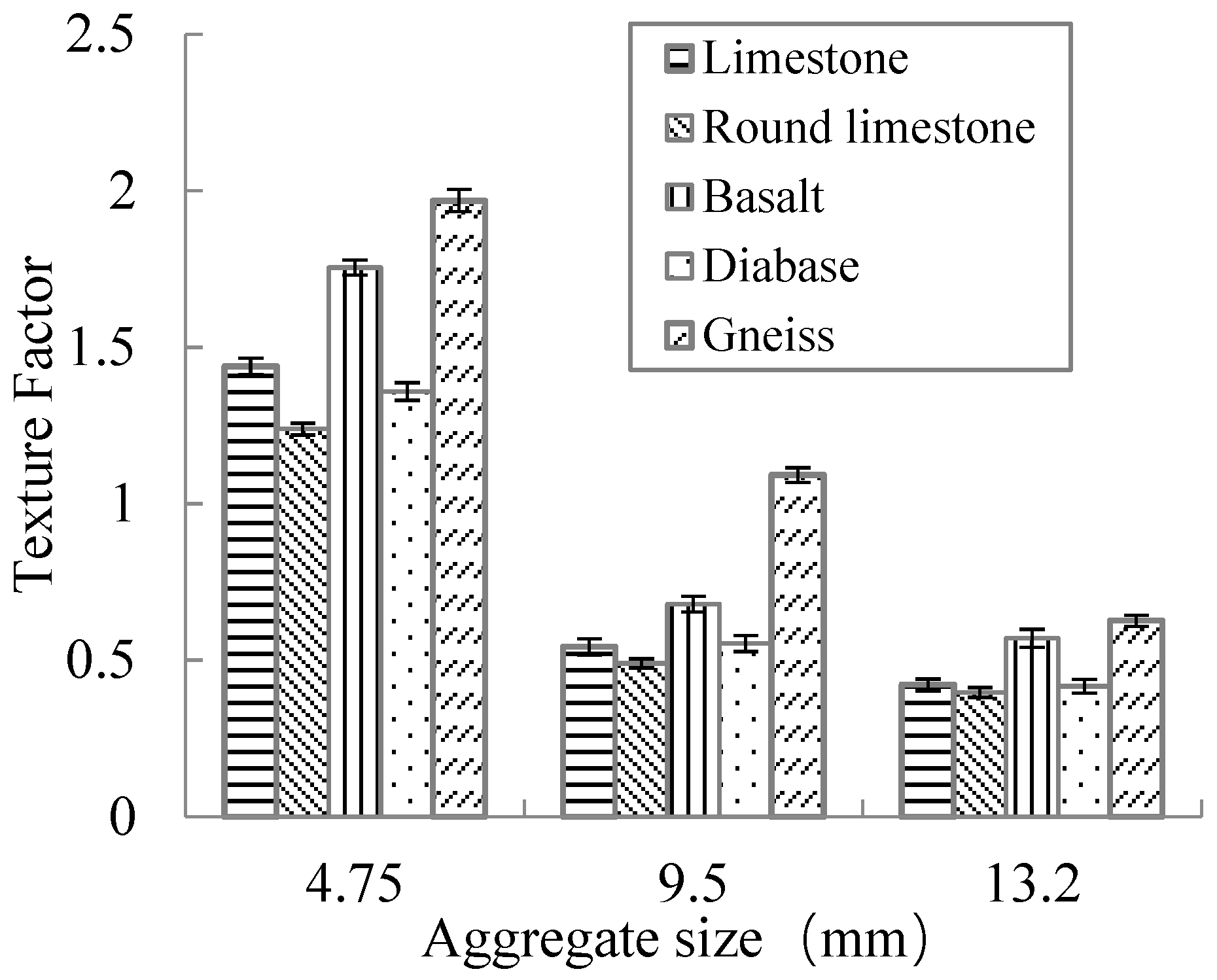
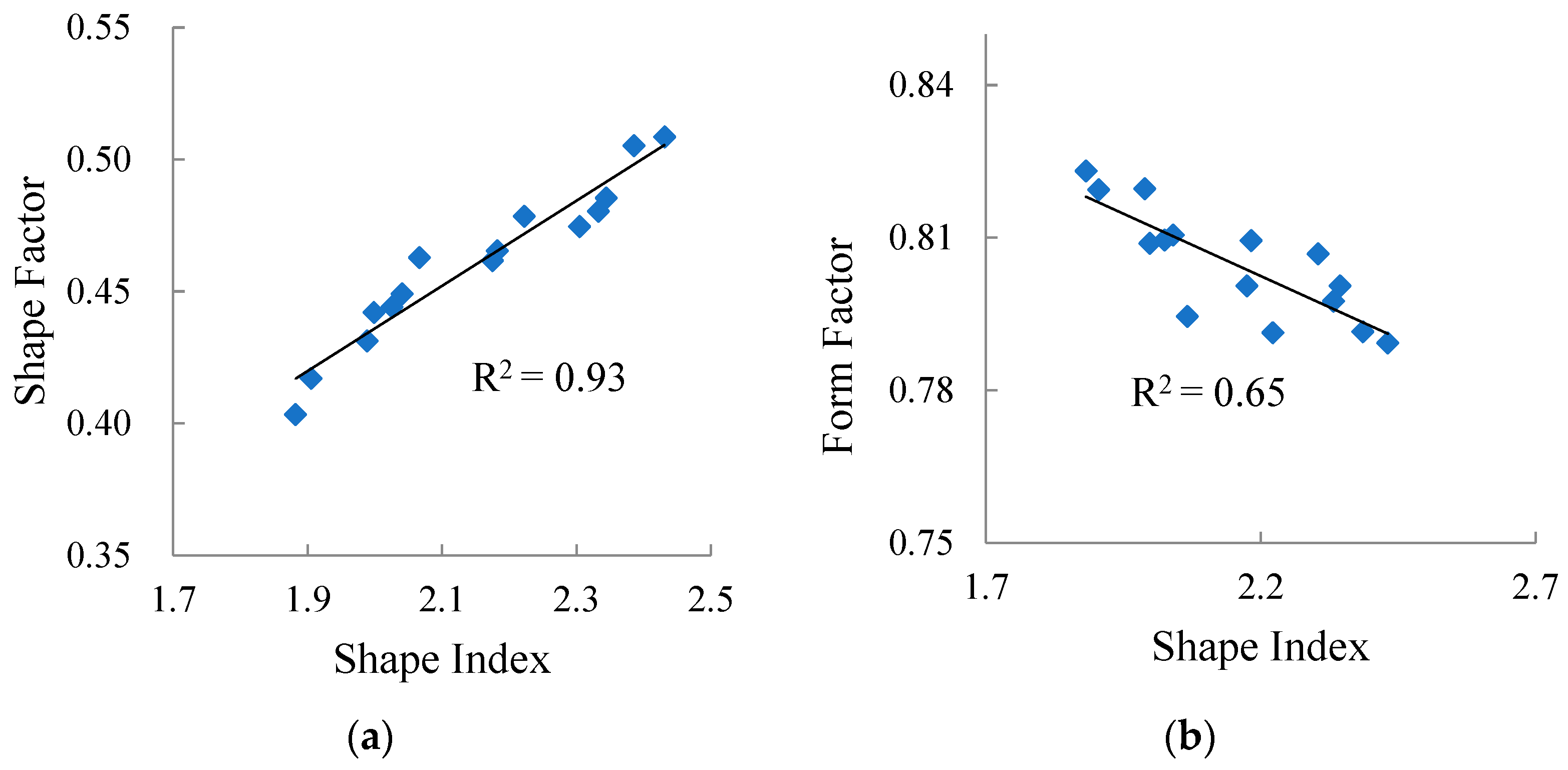
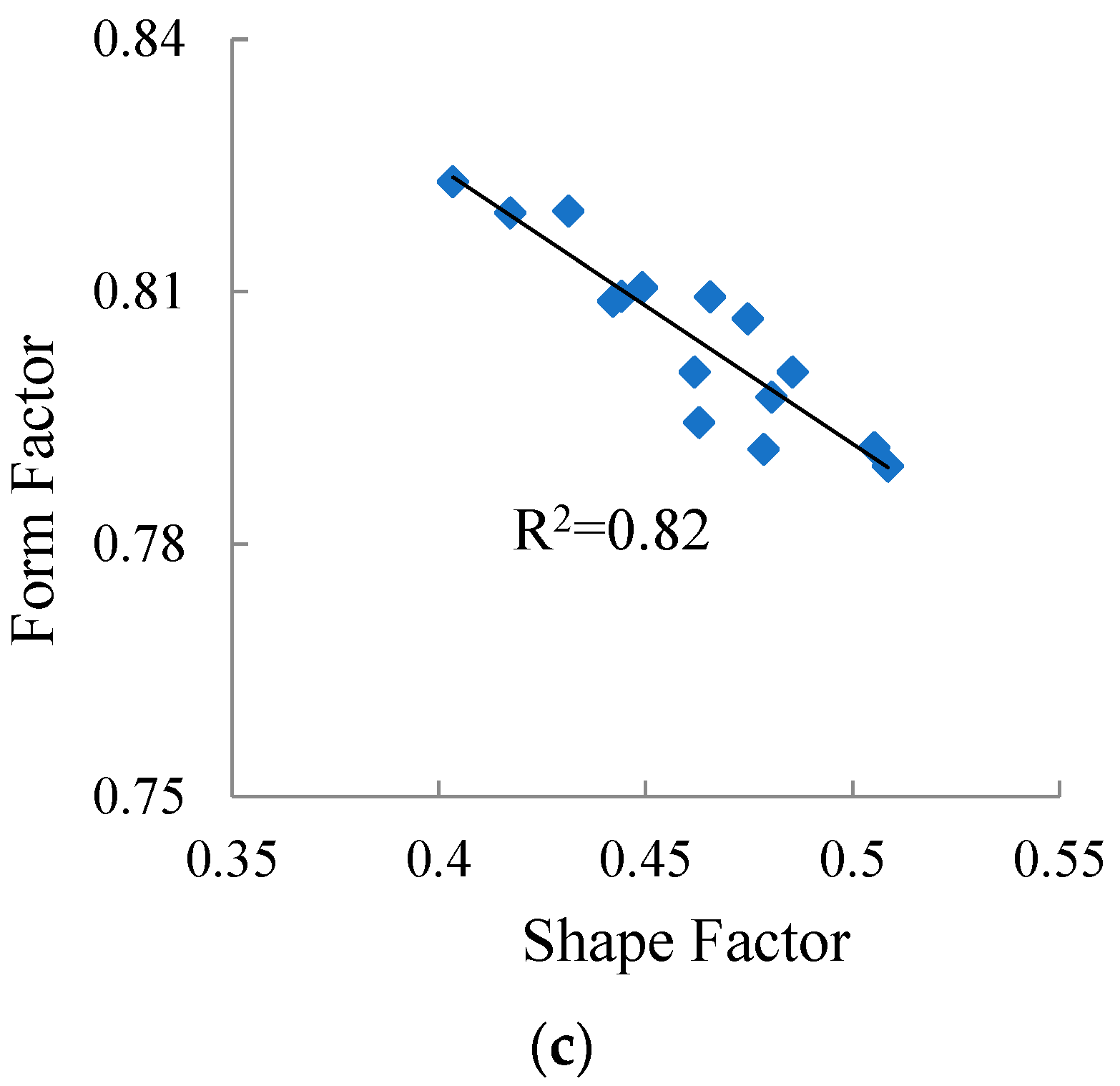
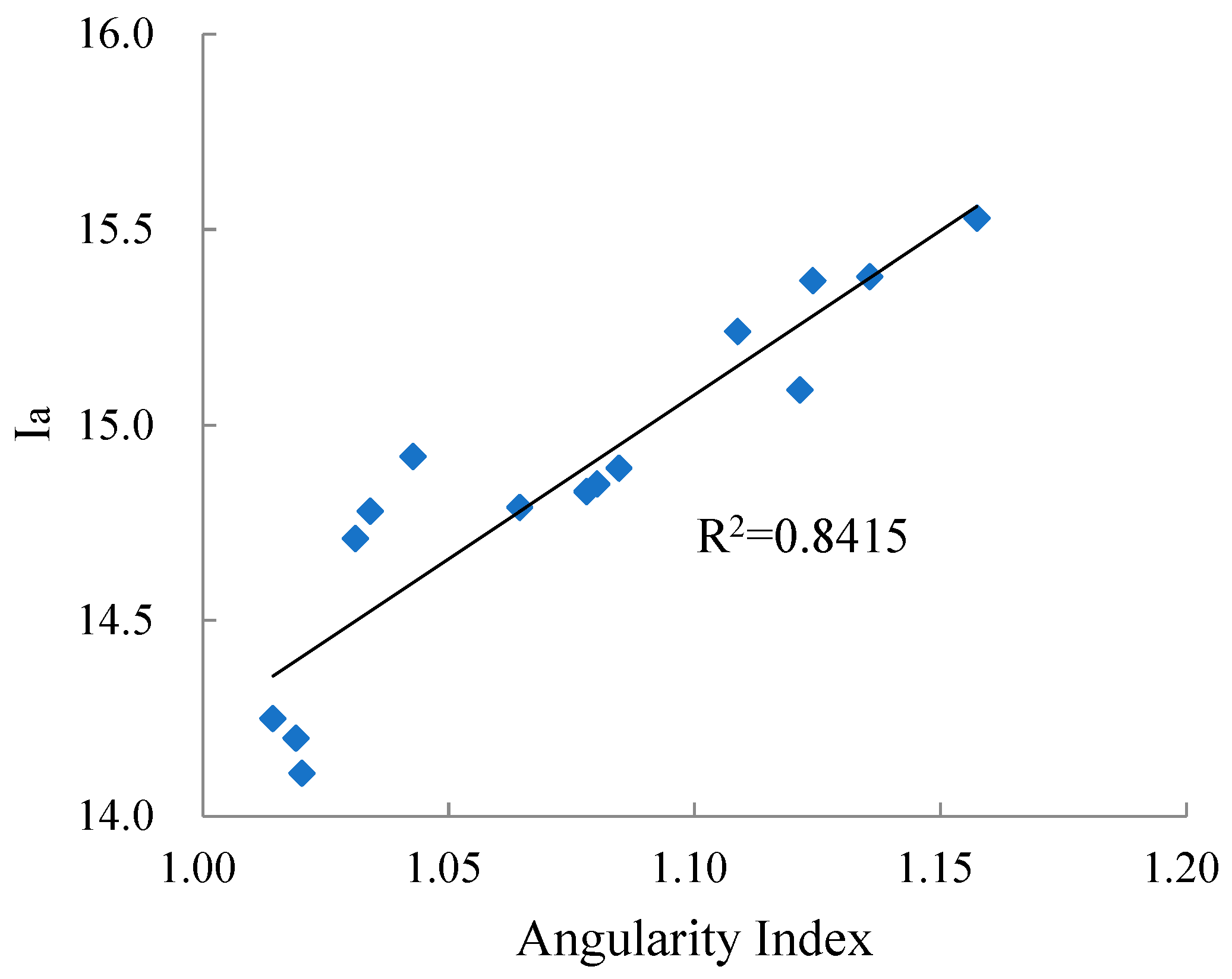
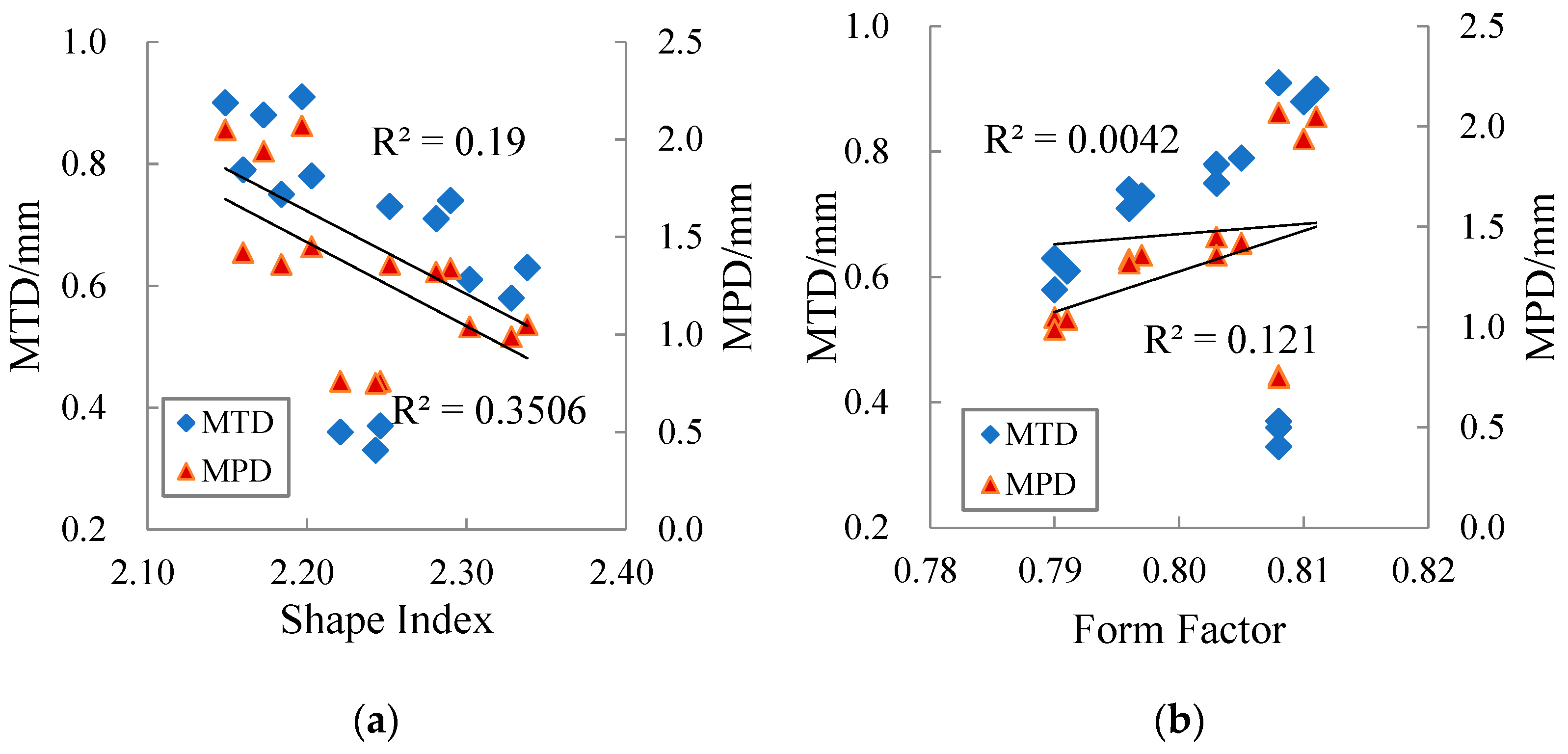

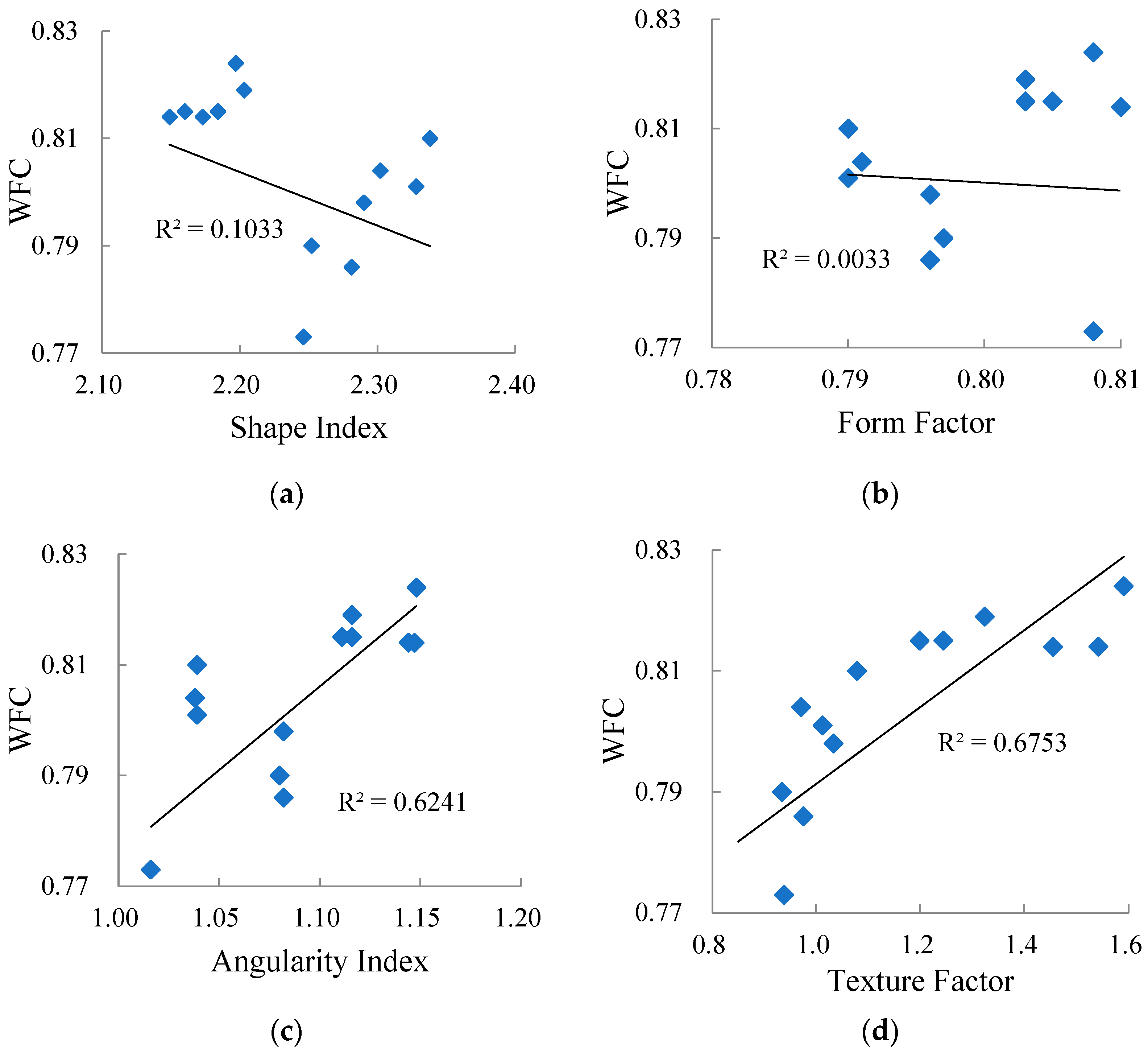

| Number | Aggregate with Particle Size of 2.36 mm | Aggregate with Particle Size 2.36 mm | Aggregate Gradation | Asphalt Type |
|---|---|---|---|---|
| 1 | Limestone | Limestone | AC-13 coarse, AC-13 target and AC-13 fine | SBS modified asphalt |
| 2 | Round limestone | |||
| 3 | Basalt | |||
| 4 | Diabase | |||
| 5 | Gneiss |
| Gradation Type | 16 | 13.2 | 9.5 | 4.75 | 2.36 | 1.18 | 0.6 | 0.3 | 0.15 | 0.075 |
|---|---|---|---|---|---|---|---|---|---|---|
| AC-13 coarse | 100 | 91 | 70 | 42 | 28 | 18 | 13 | 9 | 6 | 5 |
| AC-13 target | 100 | 96 | 78 | 44 | 33 | 23 | 17 | 11 | 9 | 6 |
| AC-13 fine | 100 | 99 | 83 | 64 | 46 | 35 | 25 | 18 | 14 | 7 |
| Aggregate Type | F | F0.05 (2477) |
|---|---|---|
| Limestone | 921.496 | 3.015 |
| Round limestone | 781.542 | |
| Basalt | 804.315 | |
| Diabase | 764.862 | |
| Gneiss | 684.210 |
| Aggregate Size (mm) | F | F0.05 (4795) |
|---|---|---|
| 4.75 | 189.885 | 2.383 |
| 9.5 | 105.214 | |
| 13.2 | 129.643 |
| Test Results | 4.75 mm | 9.5 mm | 13.2 mm | Σ |
|---|---|---|---|---|
| Proportion of aggregate of a certain particle size in the gradation (%) | 34 | 18 | 4 | 56 |
| Proportion of aggregate of a certain particle size in coarse aggregate (%) | 60.71 | 32.14 | 7.14 | 100 |
| SI of aggregate | 2.4312 | 2.224 | 2.0664 | — |
| FF of aggregate | 0.7893 | 0.7913 | 0.7945 | — |
| AI of aggregate | 1.0427 | 1.0340 | 1.0310 | — |
| TF of aggregate | 1.4386 | 0.5428 | 0.4211 | — |
| Average SI of aggregates in the mixture (i.e., SIa) | 2.338 | |||
| Average FF of aggregates in the mixture (i.e., FFa) | 0.790 | |||
| Average AI of aggregates in the mixture (i.e., AIa) | 1.039 | |||
| Average TF of aggregates in the mixture (i.e., TFa) | 1.078 | |||
| Aggregate Type | Gradation Type | SIa | FFa | AIa | TFa |
|---|---|---|---|---|---|
| Limestone | AC-13 coarse | 2.302 | 0.791 | 1.038 | 0.971 |
| AC-13 target | 2.338 | 0.790 | 1.039 | 1.078 | |
| AC-13 fine | 2.328 | 0.790 | 1.039 | 1.012 | |
| Round limestone | AC-13 coarse | 2.221 | 0.808 | 1.017 | 0.849 |
| AC-13 target | 2.246 | 0.808 | 1.016 | 0.938 | |
| AC-13 fine | 2.243 | 0.808 | 1.017 | 0.883 | |
| Basalt | AC-13 coarse | 2.160 | 0.805 | 1.111 | 1.199 |
| AC-13 target | 2.203 | 0.803 | 1.116 | 1.324 | |
| AC-13 fine | 2.184 | 0.803 | 1.116 | 1.244 | |
| Diabase | AC-13 coarse | 2.252 | 0.797 | 1.080 | 0.934 |
| AC-13 target | 2.290 | 0.796 | 1.082 | 1.033 | |
| AC-13 fine | 2.281 | 0.796 | 1.082 | 0.975 | |
| Gneiss | AC-13 coarse | 2.149 | 0.811 | 1.144 | 1.455 |
| AC-13 target | 2.197 | 0.808 | 1.148 | 1.591 | |
| AC-13 fine | 2.173 | 0.810 | 1.147 | 1.542 |
Publisher’s Note: MDPI stays neutral with regard to jurisdictional claims in published maps and institutional affiliations. |
© 2022 by the authors. Licensee MDPI, Basel, Switzerland. This article is an open access article distributed under the terms and conditions of the Creative Commons Attribution (CC BY) license (https://creativecommons.org/licenses/by/4.0/).
Share and Cite
Sun, P.; Zhang, K.; Han, S.; Xiao, Y. Aggregate Geometrical Features and Their Influence on the Surface Properties of Asphalt Pavement. Materials 2022, 15, 3222. https://doi.org/10.3390/ma15093222
Sun P, Zhang K, Han S, Xiao Y. Aggregate Geometrical Features and Their Influence on the Surface Properties of Asphalt Pavement. Materials. 2022; 15(9):3222. https://doi.org/10.3390/ma15093222
Chicago/Turabian StyleSun, Pei, Ke Zhang, Sen Han, and Yun Xiao. 2022. "Aggregate Geometrical Features and Their Influence on the Surface Properties of Asphalt Pavement" Materials 15, no. 9: 3222. https://doi.org/10.3390/ma15093222
APA StyleSun, P., Zhang, K., Han, S., & Xiao, Y. (2022). Aggregate Geometrical Features and Their Influence on the Surface Properties of Asphalt Pavement. Materials, 15(9), 3222. https://doi.org/10.3390/ma15093222







